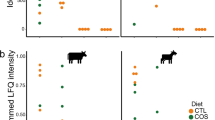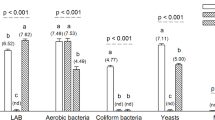Abstract
DURING recent years, increasing attention has been paid to the role of the rumen ciliate protozoa in ruminant nutrition, particularly with regard to the fermentative activity of the holotrich protozoa which contribute to the production of lactic and volatile fatty acids1,2. It has, however, become evident that further progress in this direction cannot be made until the contribution of each component species of the rumen microfauna can be studied separately both in vitro and in vivo. Attempts to cultivate the rumen ciliates in vitro have hitherto not met with outstanding success. Gutierrez3 managed to separate the two holotrich genera in vitro but only to give a limited yield. The differences in fermentation reactions in vitro found by Gutierrez between Isotricha Stein and Dasytricha Schuberg (cf. Oxford2) seem to justify attempts to establish single species of holotrichs in vivo unmixed with other species. A method is required which would be as effective as, but less drastic than, the use of prolonged starvation and copper sulphate administration4. This objective has so far been reached by us in the one sheep used, to the extent that all three species of holotrichs and the large oligotrichs originally present were removed, leaving only the smaller oligotrich Diplodinium dentatum Stein and a few Entodinia spp. Following this, Dasytricha ruminantium has successfully been reestablished in the rumen so that fairly large ‘pure’ samples of this organism in the living state can now be obtained for in vitro studies, by the normal separation process of Heald, Oxford and Sugden5.
This is a preview of subscription content, access via your institution
Access options
Subscribe to this journal
Receive 51 print issues and online access
$199.00 per year
only $3.90 per issue
Buy this article
- Purchase on SpringerLink
- Instant access to full article PDF
Prices may be subject to local taxes which are calculated during checkout
Similar content being viewed by others
References
Hungate, R. E., “Biochemistry and Physiology of Protozoa”, 2, edit. by Hutner, S. M., and Lwoff, A. (Academic Press, New York,1955).
Oxford, A. E., Parasitol. Rev., 4, 569 (1955).
Gutierrez, J., Biochem. J., 60, 516 (1955).
Becker, E. R., Schulz, J. A., and Emmerson, M. A., Iowa State Coll. J. Sci., 4, 215 (1930).
Heald, P. J., Oxford, A. E., and Sugden, B., Nature, 169, 1055 (1952).
Hill, K. J., Quart. J. Exp. Physiol., 40, 32 (1955).
Author information
Authors and Affiliations
Rights and permissions
About this article
Cite this article
MARGARET EADIE, J., OXFORD, A. A Simple and Safe Procedure for the Removal of Holotrich Ciliates from the Rumen of an Adult Fistulated Sheep. Nature 179, 485 (1957). https://doi.org/10.1038/179485a0
Issue date:
DOI: https://doi.org/10.1038/179485a0
This article is cited by
-
Influence of two defaunating agents and defaunation intervals on milk profile and selected serum parameters in lactating dairy goats in Egypt
Comparative Clinical Pathology (2023)



